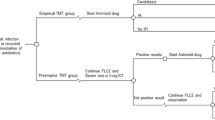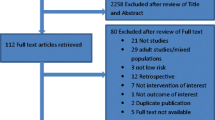Abstract
Febrile neutropenia is a condition that can develop in patients with cancer following the administration of myelosuppressive chemotherapy or radiation therapy. The current standard of patient management involves the empirical use of a combination of antibacterials or a single broad spectrum agent to offer extensive antibacterial coverage of both Gram-positive and Gram-negative microorganisms.
Over the past 25 years, febrile neutropenia has changed from a condition that was fatal in over 50% of patients to a conditionwith an infection-relatedmortality rate of less than 10%. A major reason behind these extraordinary advances in patient care has been the many well-designed randomised trials of empirical antibacterial therapy that have been conducted over this period of time. In contrast to this finding, a review of the literature revealed limited economic data on the empirical treatment of febrile neutropenia in patientswith cancer. Therefore, there is a definite need to conduct more pharmacoeconomic research in this area and to develop methods of implementing the findings of such studies.
Similar content being viewed by others
References
Pizzo PA. Management of fever in patients with cancer and treatment-induced neutropenia. N Engl J Med 1993; 328: 1323–32
Pizzo PA, Myers J, Freifeld AG, et al. Infections in the cancer patient. In: Devita VT, Hellmann S, Rosenberg SA, et al., editors. Cancer: principles and practice of oncology. 4th ed. Philadelphia (PA): JB Lippincott Company, 1993: 2292–337
Hellman S. Principles of radiation therapy. In: Devita VT, Hellmann S, Rosenberg SA, et al., editors. Cancer: principles and practice of oncology. 4th ed. Philadelphia (PA): JB Lippincott Company, 1993: 248–77
Bodey GP, Buckley M, Sathe YS, et al. Qualitative relationship between circulating leukocytes and infection in patients with acute leukemia. Ann Intern Med 1996; 64: 328–40
Schimpff SC. Infections in the compromised host. In: Mandell G, Douglas RG, Bennett JE, et al., editors. Principles and practise of infectious diseases. 3rd ed. New York (NY): Churchill Livingstone, 1990: 2258–65
McCabe WR, Jackson GG. Gram negative bacteremia. II: clinical, laboratory and therapeutic observations. Arch InternMed 1962; 110: 856–64
Schimpff S, Satterlee W, Young WM, et al. Empirical therapy with carbenicillin and gentamicin for febrile patients with cancer and granulocytopenia. N Engl JMed 1971; 284: 1061–5
Hughes WT, Armstrong D, Bodey GP, et al. Guidelines for the use of antimicrobial agents in neutropenic patients with unexplained fever. J Infect Dis 1990; 161: 381–96
Lalla de F. Antibiotic treatment of febrile episodes in neutropenic cancer patients. Drugs 1997; 53: 789–804
EORTC International Antimicrobial Therapy Project Group. Combination of amikacin and carbenicillin with or without cefazolin as empirical treatment of febrile neutropenic patients. J Clin Oncol 1983; 1: 597–603
EORTC International Antimicrobial Therapy Project Group. Three antibiotic regimens in the treatment of infection in febrile granulocytopenic patients with cancer. J Infect Dis 1978; 137: 14–29
Bodey GP, Feld R, Burgess MA. Beta-lactam antibiotics alone or in combination with gentamicin for therapy of gram-negative bacillary infections in neutropenic patients. Am J Med Sci 1976; 271: 179–86
Hathorn JW, Kirsten L. Empirical treatment of febrile neutropenia: evolution of current therapeutic approaches. Clin Infect Dis 1997; 24 Suppl. 2: S56–65
Bodey GP, Fainstein V, Elting LS, et al. Beta-lactam regimens for the febrile neutropenic patient. Cancer 1990; 65: 9–16
Johnson MP, Ramphal R. β-lactam-resistant enterobacter bacteremia in febrile neutropenic patients receiving monotherapy. J Infect Dis 1990; 162: 981–3
de Pauw B, Deresinski SC, Feld R, et al. Amulticenter randomized trial of ceftazidime alone versus piperacilin plus tobramycin for empiric antimicrobial therapy of 784 episodes of fever and neutropenia in patients with neoplastic diseases. Ann Intern Med 1994; 120: 834–44
The Meropenem Study Group of Leuven, London and Nijmegen. Equivalent efficacies of meropenem and ceftazidime as empirical monotherapy of febrile neutropenic patients. J Antimicrob Chemother 1995; 36: 185–200
Biron P, Fuhrmann C, Cure H, et al.Cefepime versus imipenemcilastatin as empirical monotherapy in 400 febrile patients with short duration neutropenia. J Antimicrob Chemother 1998; 42: 511–8
Freifeld AG, Walsh T, Marshall D, et al.Monotherapy for fever and neutropenia in cancer patients: a randomized comparison of ceftazidime versus imipenem. J Clin Oncol 1995; 13: 165–76
Hess U, Bohme C, Rey K, et al. Monotherapy with piperacillin/tazobactam vs. combination therapy with ceftazidime plus amikacin as an empiric therapy for fever in neutropenic cancer patients. Support Care Cancer 1998; 6: 402–9
Bohme A, Shah PM, Stille W, et al. Piperacillin/tazobactam versus cefepime as initial empirical antimicrobial therapy in febrile nuetropenic patients: a prospective randomized pilot study. Eur J Med Res 1998; 3: 324–30
Klastersky J. Empirical therapy for bacterial infections in neutropenic patients. Support Care Cancer 1994; 2: 347–54
Shenep JL, Hughes WT, Roberson PK, et al. Vancomycin, ticarcillin and amikacin compared to ticarcillin-clavulanate and amikacin in the empirical management of febrile neutropenic children with cancer. N Engl J Med 1988; 319: 1053–8
Karp JE, Dick JD, Angelopoulos C, et al. Empiric use of vancomycin during prolonged treatment-induced granulocytopenia: randomized, double-blind, placebo-controlled trial in patients with acute leukemia. Am J Med 1986; 81: 237–42
EORTC International Antimicrobial Therapy Project Group. Vancomycin added to empirical combination antibiotic therapy for fever in granulocytopenic cancer patients. J Infect Dis 1991; 163: 951–8
Koya R, Anderson J, Fernandex H, et al. Analysis of the value of empiric vancomycin administration in febrile neutropenia occurring after autologous peripheral blood stem cell transplants. Bone Marrow Transplant 1998; 21: 923–6
Hughes WT, Armstrong D, Bodey GP, et al. 1997 guidelines for the use of antimicrobial agents in neutropenic patients with unexplained fever. Clin Infect Dis 1997: 25: 551–73
Wade JC. Antibiotic therapy for the febrile granulocytopenic cancer patient: combination therapy vs. monotherapy. Rev Infect Dis 1989; 11 Suppl. 7: S1572–81
Pizzo PA, Hathorn JW, Hiemenz J, et al. A randomized trial comparing ceftazidime alone with combination antibiotic therapy in cancer patients with fever and neutropenia. N Engl J Med 1986; 315: 552–8
Klastersky J. Treatment of neutropenic infection: trends toward monotherapy? Support Care Cancer 1997; 5: 365–70
EORTC International Antimicrobial Therapy Cooperative Group. Gram-positive bacteremia in granulocytopenic cancer patients: results of a prospective randomized therapeutic trial. Eur J Cancer Clin Oncol 1990; 26: 569–74
Leclercq R. Antibiotic resistance in streptococci and enterococci: where are we and were arewe going? Adv Exp Med Biol 1997; 418: 419–27
Dornbusch K, King A, Legakis N. Incidence of antibiotic resistance in blood and urine isolates from hospitalized patients: report from a European collaborative study. Scan J Infect Dis 1998; 30: 281–8
Verhagens CS, De Pauw B, De Witte T, et al. Randomized prospective study of ceftazidime versus ceftazidime plus cephalothin in empiric treatment of febrile episodes in severely neutropenic patients. Antimicrob Agents Chemother 1987; 31: 191–6
Eggimann P, Glauser MP, Aoun M, et al. Cefepime monotherapy for the empirical treatment of fever in granulocytopenic cancer patients. J Antimicrob Chemother 1993; 32 Suppl. B: 151–63
Dranitsaris G, Tran TM, McGeer AJ, et al. Pharmacoeconomic analysis of empiric therapy with ceftazidime alone or combination antibiotics for febrile neutropenia in cancer patients. Pharmacoeconomics 1995; 7: 49–62
Dranitsaris G, Altmayer C, Quirt I. Cost-benefit analysis of prophylactic granulocyte colony-stimulating factor in CHOP chemotherapy for non-Hodgkin’s lymphoma. Pharmacoeconomics 1997; 11: 566–77
Messori A, Trippoli S, Tendi E. G-CSF for the prophylaxis of neutropenic fever in patients with small cell lung cancer receiving myelosuppressive antineoplastic chemotherapy: meta-analysis and pharmacoeconomic evaluation. J Clin Pharm Ther 1996; 21: 57–63
D’Antonio D, Piccolomini R, Iacone A, et al. Comparison of ciprofloxacin, ofloxacin and perfloxacin for the prevention of bacterial infection in neutropenic patients with haematological malignancies. J Antimicrob Chemother 1994; 33: 837–44
Dennig D, Fulle HH, Hellriegel KP. Chemoprophylaxis of bacterial infections in granulocytopenic patients with ciprofloxacin. Onkologie 1987; 10: 57–8
Carlson JW, Fowler JM, Saltzman AK, et al. Chemoprophylaxis with oral ciprofloxacin in ovarian cancer patients receiving taxol. Gynecol Oncol 1994; 55: 415–20
Dranitsaris G, Sutcliffe SB. Economic analysis of prophylactic G-CSF after mini-BEAM salvage chemotherapy for Hodgkin’s and non-Hodgkin’s lymphoma. Leuk Lymphoma 1995; 17: 139–45
Bennett CL, George SL, Vose JM, et al. Granulocyte-macrophage colony-stimulating factor as adjunct therapy in relapsed lymphoid malignancy: implications for economic analyses of phase III clinical trials. Stem Cells 1995; 13: 414–20
Lyman GH, Lyman CG, Sanderson RA, et al. Decision analysis of hematopoietic growth factor use in patients receiving cancer chemotherapy. J Natl Cancer Inst 1993; 85: 488–93
Vellenga E, Uyl-de Groot, de Wit HJ, et al. Randomized placebo-controlled trial of granulocyte macrophage colony stimulating factor in patients with chemotherapy related neutropenia. J Clin Oncol 1996; 14: 619–27
Hartman LC, Tschetter LK, Habermann TM, et al. Granulocyte colony stimulating factor in severe chemotherapy induced afebrile neutropenia. N Engl J Med 1997; 336: 1776–80
Anaissie EJ, Vartivarian S, Bodey GP, et al. Randomized comparison between antibiotics alone and antibiotics plus granulocyte-macrophage colony-stimulating factor in cancer patients with fever and neutropenia. JAMA 1996; 100: 17–23
Talcott JA, Siegel RD, Finberg R, et al. Risk assessment in cancer patients with fever and neutropenia: a prospective, two-centre validation study of a prediction rule. J Clin Oncol 1992; 10: 316–22
Anaissie EJ, Vadhan-Raj S. Is it time to redefine the management of febrile neutropenia in cancer patients? JAMA 1995; 98: 221–3
Rubenstein EB, Rolston K, Benjamin RS, et al. Outpatient treatment of febrile episodes in low-risk neutropenic patients with cancer. Cancer 1993; 71: 3640–6
Talcott JA, Whalen A, Clark J, et al. Home antibiotic therapy for low-risk cancer patients with fever and neutropenia: a pilot study of 30 patients based on a validated prediction rule. J Clin Oncol 1994; 12: 107–17
Malik IA, Khan WA, Karim M, et al. Feasibility of outpatient management of fever in cancer pateints with low-risk neutropenia: results of a prospective randomized trial. Am J Med 1995; 98: 224–31
Gaynes R, Monnet D. The contribution of antibiotic use on the frequency of antibiotic resistance in hospitals. Ciba Found Symp 1997; 207: 47–56
Gidson J, Johnson L, Snowdown L, et al. Arandomized dosage study of ceftazidime with single daily tobramycin for the empirical management of febrile neutropenia in patients with hematological diseases. Int J Hematol 1994; 60: 119–27
Dranitsaris G, Warr D, Puodziunas A. A randomized trial of the effects of pharmacist intervention on the cost of antiemetic therapy with ondansetron. Support Care Cancer 1995; 3: 183–9
Singer MV, Haft R, Barlam T, et al. Vancomycin control measures at a tertiary hospital: impact of interventions on volume and patterns of use. Infect Control Hosp Epidemiol 1998; 19: 248–53
Author information
Authors and Affiliations
Corresponding author
Rights and permissions
About this article
Cite this article
Dranitsaris, G. Clinical and Economic Considerations of Empirical Antibacterial Therapy of Febrile Neutropenia in Cancer. Pharmacoeconomics 16, 343–353 (1999). https://doi.org/10.2165/00019053-199916040-00003
Published:
Issue Date:
DOI: https://doi.org/10.2165/00019053-199916040-00003




